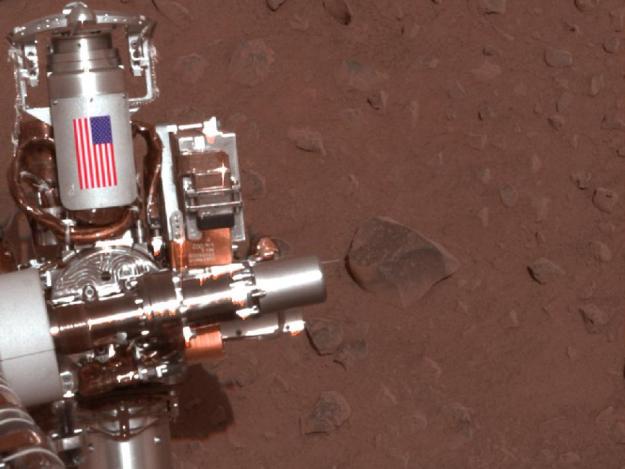
The offices of Honeybee Robotics were located less than a mile from the World Trade Center in 2001. In September of that year, the company was building grinding tools for NASA’s Mars Exploration Rovers Spirit and Opportunity.
Following the terrorist attacks of September 11, the employees of Honeybee struggled to find a way to offer help or a tribute as they were weighed down by the necessarily-firm NASA deadlines required for equipment testing. But eventually Honeybee found the perfect opportunity.
The design of the grinders called for a plain aluminum shield to cover the tool’s control cables. Working with New York City mayor’s office, a metal-working shop in Texas and NASA’s Jet Propulsion Laboratory in California, Honeybee decided to fabricate the shields out of aluminum recovered from the World Trade Center towers. With images of American flags attached, both shields now serve as a permanent tribute on Mars. On the photo of Spirit above, the shield is the dull metal piece at top left.
The Spirit rover was launched all the way back in June 2003, with Opportunity launched that July. By January of 2004 they’d both landed safely on Mars. Their primary missions were both completed three months later. The grinders designed by Honeybee were used initially in rock sampling; they allowed both rovers to cut through the crust on Martian rocks to analyze their contents.
Interestingly, it wasn’t until the end of 2004 that anyone from Honeybee spoke publicly about where the shields’ aluminum had come from. That November, in a profile of Honeybee by the New York Times, Honeybee CEO Stephen Gorevan spoke of the shields.
“It was intended to be a quiet tribute,” he said. “Enough time has passed. We want the families to know.”
The rovers continued their work long after that. Opportunity is actually still active, while Spirit quit communications in spring of last year. During that span both rovers have used their penchant for geological study to vastly increase our knowledge about ancient Mars’ wet environments and their potential for supporting life.
After Opportunity goes silent, both rovers will remain in good condition for years to come thanks to Mars’ dry, cold environment. Even when they’re nonoperational, the rovers will continue carrying out their mission as the only interplanetary tribute to September 11.
Lead photo via NASA/JPL-Caltech/Cornell University
Editors' Recommendations
- NASA is operating its Mars Curiosity rover from workers’ home offices
- NASA to announce Mars 2020 rover name, here’s how to watch
- NASA’s Mars 2020 rover will search for evidence of ancient life on red planet
- NASA’s underwater rover will hunt for life on distant ocean worlds
- NASA’s Mars 2020 rover practices its crucial descent separation


